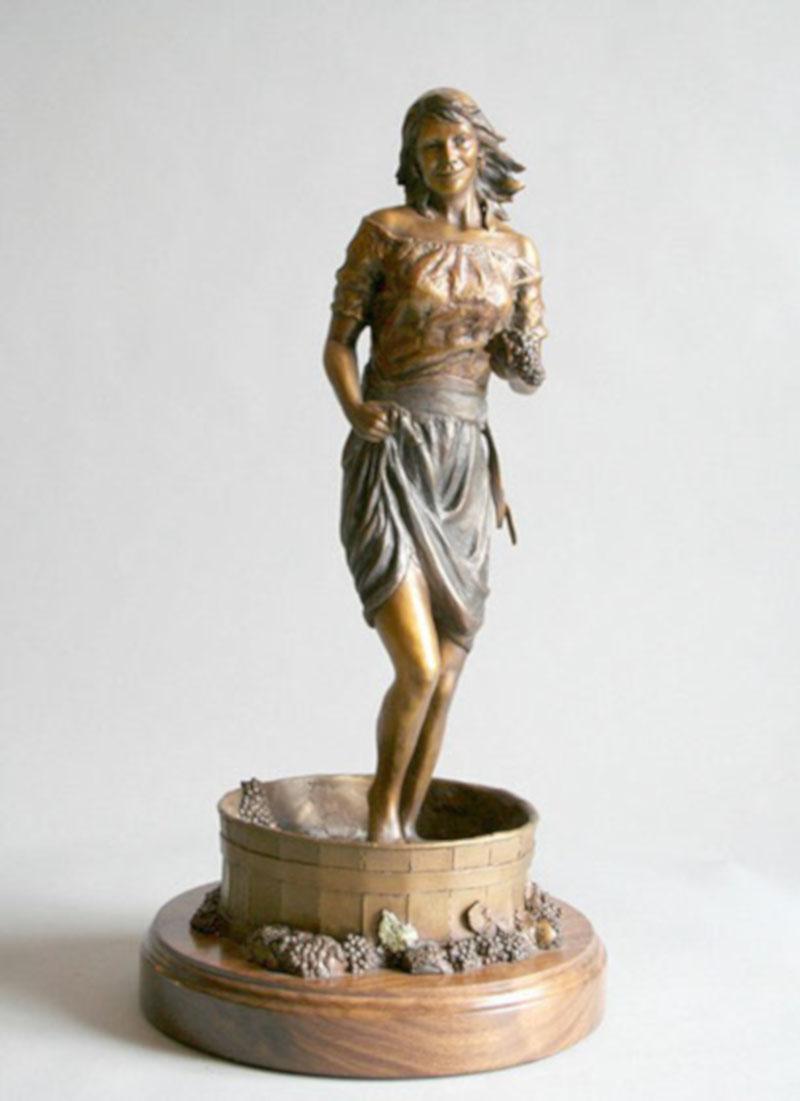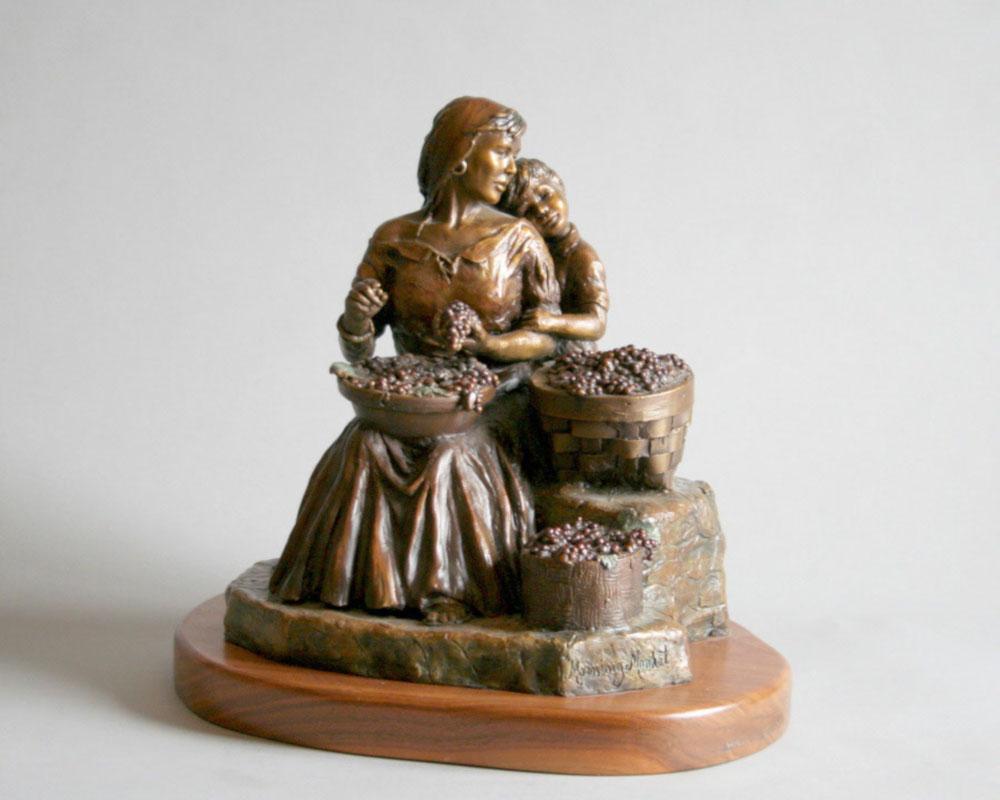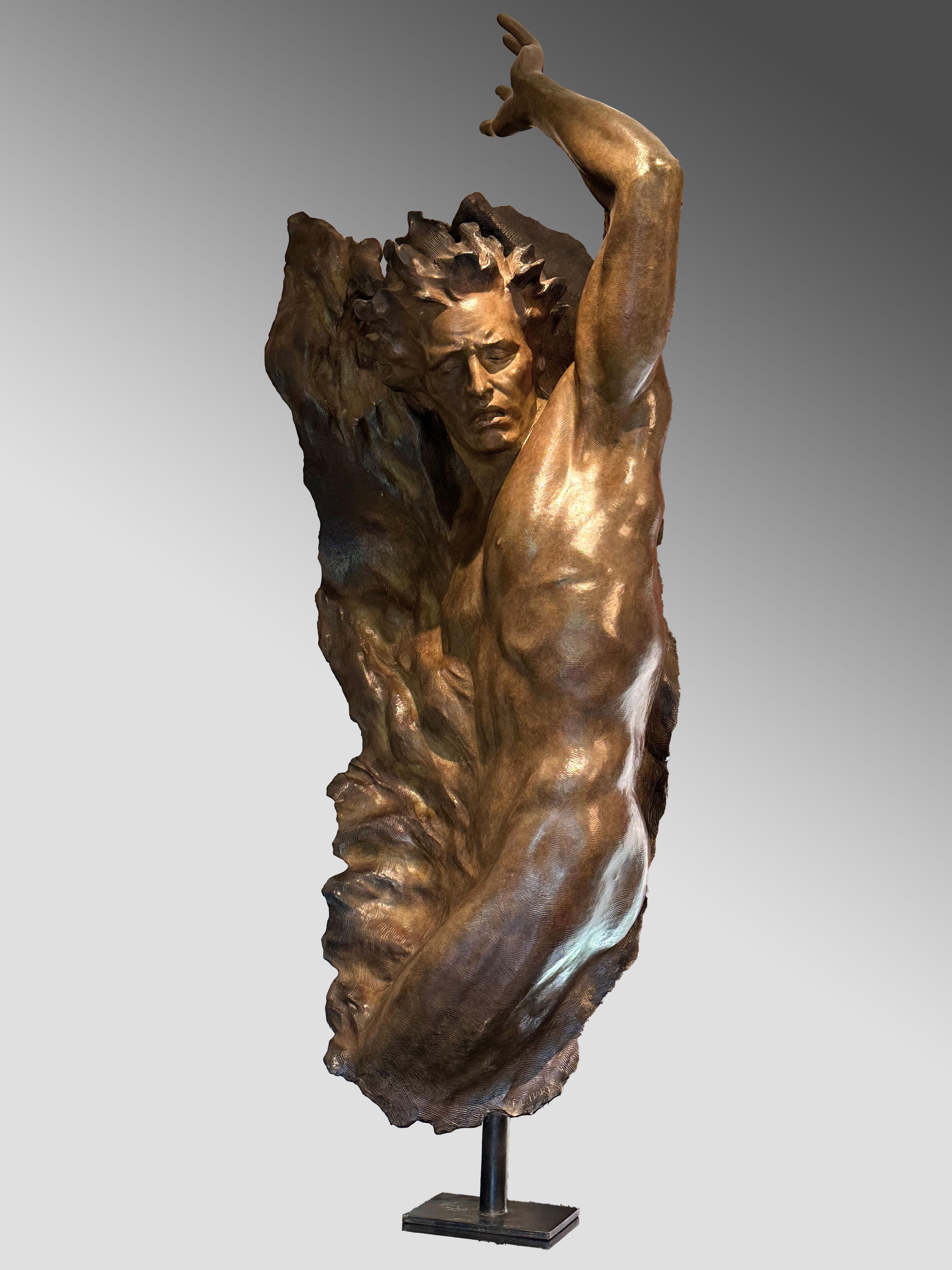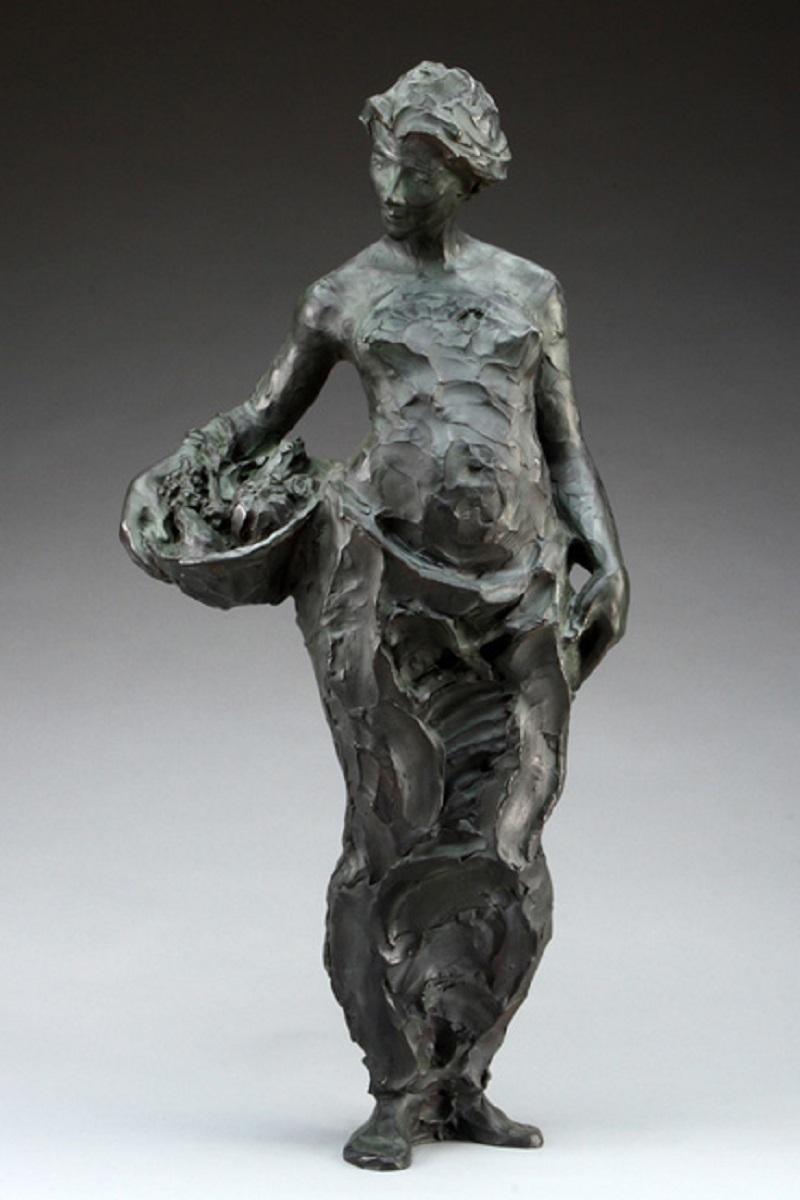Edgar DegasCertified Edgard Degas Bronze of a horse : (Horse walking at a high pace)c.1887–8
c.1887–8
About the Item
- Creator:Edgar Degas (1834-1917, French)
- Creation Year:c.1887–8
- Dimensions:Height: 9.26 in (23.5 cm)Width: 8.86 in (22.5 cm)Depth: 3.55 in (9 cm)
- Medium:
- Movement & Style:
- Period:
- Condition:
- Gallery Location:Gent, BE
- Reference Number:1stDibs: LU2140211311932
Edgar Degas
Edgar Degas, born Hilaire-Germain-Edgar De Gas in Paris in 1834, was the oldest of five children of Célestine Musson De Gas, a Creole from New Orleans, and Augustin De Gas, a banker. Degas began his schooling at age eleven, enrolling in the Lycée Louis-le-Grand, but after his mother died when he was thirteen, his father and grandfather became the main influences on him for the remainder of his youth.
Upon graduating the Lycée in 1853, at age 18, he registered as a copyist in the Louvre Museum, but his father expected him to go to law school. Degas duly enrolled at the faculty of law of the University of Paris, in November 1853, but applied little effort to his studies. In 1855, Degas met Jean-Auguste-Dominique Ingres, whose advice he never forgot: “Draw lines, young man, and still more lines, both from life and from memory, and you will become a good artist.” In April of that year, Degas was admitted to the École des Beaux-Arts.
Evidence of Degas’ classical education can be seen in his early painting, Young Spartans Exercising (ca. 1860; National Gallery, London), done while he was still in his twenties. After 1865, when the Salon accepted his history painting The Misfortunes of the City of Orléans (Musée d'Orsay, Paris), Degas did not paint Academic subjects again, focusing his attention on scenes of modern life. He began to paint scenes of such urban leisure activities as horse racing and, after about 1870, of café-concert singers and ballet dancers. Degas' interest in ballet dancers intensified in the 1870s, and eventually he produced approximately 1,500 works on the subject. These are not traditional portraits, but studies that address the movement of the human body, exploring the physicality and discipline of the dancers through the use of contorted postures and unexpected vantage points.
Following the opening of trade with Japan in 1854, many French artists, including Degas, were increasingly influenced by Japanese prints. Degas abstracted from these prints their inventive compositions and points of view, particularly in his use of cropping and asymmetry [Dancers Practicing at the Bar (1877); Dancers, Pink and Green (ca. 1890)]. He also observed how sixteenth-century Italian Mannerists similarly framed their subjects, sometimes cutting off part of a figure.
Degas had an interest in a wide range of media, including engraving, monotype, and photography. Before 1880, he generally used oils for his completed works, but after 1875, he began using pastels more frequently, even in finished works such as Portraits at the Stock Exchange (1876). He submitted a suite of nudes, all rendered in pastel, to the final Impressionist exhibition in 1886; among these was Woman Bathing in a Shallow Tub (1885). The figures in these pastels were criticized for their ungainly poses.
By the late 1880s, Degas’s eyesight had begun to fail, perhaps as a result of an injury suffered during his service in defending Paris during the Franco-Prussian War of 1870–71. After that time he focused almost exclusively on dancers and nudes, increasingly turning to sculpture. Degas continued working as late as 1912, when he was forced to leave the studio in Montmartre in which he had labored for more than twenty years. He died five years later in 1917, at the age of eighty-three.
Find original Edgar Degas drawings, prints, paintings and other art on 1stDibs.
(Biography provided by Stern Pissarro Gallery)
- ShippingRetrieving quote...Ships From: Gent, Belgium
- Return PolicyA return for this item may be initiated within 10 days of delivery.
- Edgard Degas: Horse Clearing an Obstacle (work 48 /certified by Comité Degas)By Edgar DegasLocated in Gent, VOVHorse Clearing an Obstacle (work number 48) Bronze with dark brown green patina bearing the stamp of the signature "Degas", Numbered IV/IX and dated 1998 Posthumous lost wax casting as of 1998. Stamp of Valsuani. Signed Degas The work is a sought-after rarity in terms of Degas’ sculptures. This bronze is distinguished by the fact that it is a Valsuani bronze, meaning it faithfully records Degas’ wax version’s as it appeared at the time of its creation. Most Degas' bronzes that are found on the market were cast by Hébrard – these serialized bronzes are surmoulages, or “aftercasts,” that were cast from the modèle bronzes currently in the Norton Simon Museum (Pasadena). Because these Hebrard bronzes...Category
1880s Impressionist Figurative Sculptures
MaterialsBronze
- A pair of ducks by Carl August Brasch.Located in Gent, VOVA very finely detailed and stylized bronze sculpture of a pair of ducks on a marble plinth. Signed C. Brasch. In terms of approach and style, this work is modern and somewhat reminis...Category
20th Century Figurative Sculptures
MaterialsMarble, Bronze
- Antoine - Louis BARYE (1795-1875)Tiger surprising an antelope BronzeBy Antoine-Louis BaryeLocated in Gent, VOVTiger surprising an antelope (terrace without profile) Bronze with a shaded green patina, circa 1880 Signed 'BARYE', stamped 'H' by the founder Brame Antoine-Louis Barye (1796-187...Category
19th Century Figurative Sculptures
MaterialsBronze
- Wilhelm KRIEGER (A) (1877-1945) Deer. Ca 1920Located in Gent, VOVThe deer. Circa 1920. Good quality bronze model of a doe, probably cast around 1970. Standing animal, looking forward, catching the scent, tense, dynamic posture characterized only b...Category
20th Century Figurative Sculptures
MaterialsBronze
- Akop GURDJAN (après) (1881-1948) Sitting Baboon BronzeLocated in Gent, VOVAkop GURDJAN (après)(1881-1948) Sitting Baboon Bronze Akop Gurdjan (1881-1948) Akop Gurdjan (also Hakob Gyurjyan) was born in Shusha (Nagorno Karabakh)...Category
19th Century Figurative Sculptures
MaterialsBronze
- Mare - hunting horse by Josuë Dupon 1864-1935Located in Gent, VOVA beautiful large bronze sculpture of a proud standing mare. Old sand cast created during the artist Josuë Dupon's lifetime. Josuë Dupon (also Josué or Josue Dupon) was a Flemish sculptor and engraver. His work also includes painting and graphics. He received his training through evening classes at the academy of Roeselare and Antwerp (1884) and later at the National Institute of Fine Arts (1887). In 1891, he won a gold medal with the monumental sculpture group Samson kills the lion and was runner-up in the Prix de Rome for sculpture. From that year on, his work appeared regularly in exhibitions at home and abroad. His reputation was such, that he became one of a select group of sculptors allowed by King Leopold II to carve statues in Ivory, which was imported from the Congo, the Belgian colony. In 1893 his exceptionally refined ivory statue of Diana was bought by the Antwerp Royal Museum of Fine Arts, which also acquired his spectacular bronze Vulture defending its prey a year later. Working in every genre and mastering every technique and material, Josuë Dupon became best known as a sculptor of exotic animals. He was equally capable of faithfully expressing anatomical detail as of rendering the animals' nature. Josuë Dupon was a technically faultless realist, with a sense of the dramatic, a feeling for decorative complexity and a tendency towards idealizing. The placement of his camel driver and two bronze groups at the entrance to Antwerp Zoo confirmed this reputation as animalier. The career that Dupon subsequently built, brought him numerous important awards and an appointment as professor at the Antwerp Academy, a tenure he held between 1905 and 1934. Besides animals, he sculpted busts, war memorials and public monuments. For one of the largest sculptural monuments and the largest fountain in the city of Buenos Aires, called Monument of the Two Congresses, he collaborated with his good friend, the Belgian sculptor Jules Lagae. Josuë Dupon created several statues of mighty condors for this monument. At the start of his career his conception of art was strongly influenced by traditional 19th century artistic ideals. After the turn of the century his compositions and surface treatment changed and became more modern. He met Rembrandt Bugatti around 1905 or 1906 in the 'Jardin des Plantes' in Paris and invited him to Antwerp. Bugatti began travelling to Antwerp in 1906 to observe and sculpt the inhabitants of its zoo, which was then considered the best in the world, and Dupon allowed Bugatti to stay with him during several of his early visits. As such Dupon became a friend and a bit of a father figure to Rembrandt Bugatti. Dupon did not play a very active part in artistic movements or associations. Dupon remains an important sculptor not only through his body of work but also because of the influence he exercised through interactions and collaboration with other sculptors such as Lagae, Bugatti and Bourdelle but also because he trained leading sculptors such as Albéric Collin (1886-1962), Willy Kreitz...Category
19th Century Figurative Sculptures
MaterialsBronze
- "WINE DANCE" WOMAN FIGURELocated in San Antonio, TXScy Caroselli Colorado Artist Image Size: 25 inches tall Medium: Bronze "Wine Dance" Scy has been surrounded by fine art throughout her entire life. She grew up beside the easel and ...Category
2010s Impressionist Figurative Sculptures
MaterialsBronze
- "MORNING MARKET" WOMAN SITTING WITH CHILDBy ScyLocated in San Antonio, TXScy Caroselli Colorado Artist Image Size: 11 x 10 x 9 Medium: Bronze "Morning Market" Scy has been surrounded by fine art throughout her entire life. She grew up beside the easel and sculpting stand...Category
2010s Impressionist Figurative Sculptures
MaterialsBronze
- "Ex Nihilo Figure 7", Frederick Hart, Bronze Sculpture, Figurative, TraditionalBy Frederick HartLocated in Dallas, TXDon't miss this opportunity to own a piece of history! Ex Nihilo Figure 7, a full-scale plaster from the final stone sculpture of Ex Nihilo, commissioned as part of the Creation Scul...Category
Early 2000s American Impressionist Figurative Sculptures
MaterialsBronze
- "Ex Nihilo Figure 4", Frederick Hart, Bronze Sculpture, Figurative ManBy Frederick HartLocated in Dallas, TXDon't miss this opportunity to own a piece of history! Ex Nihilo Figure 4, a full-scale plaster from the final stone sculpture of Ex Nihilo, commissioned as part of the Creation Scul...Category
Early 2000s American Impressionist Figurative Sculptures
MaterialsBronze
- The Hundredth MessBy Jane DeDeckerLocated in Greenwich, CTEdition of 31 Jane DeDecker’s energetic and dynamic bronze sculptures serve as a reflection of her own life experiences and those of her closely-knit family. Her twelve nieces and ne...Category
Early 2000s American Impressionist Figurative Sculptures
MaterialsBronze
- EarthBy Jane DeDeckerLocated in Greenwich, CTEdition of 17 Jane DeDecker’s energetic and dynamic bronze sculptures serve as a reflection of her own life experiences and those of her closely-knit family. Her twelve nieces and ne...Category
Early 2000s American Impressionist Figurative Sculptures
MaterialsBronze






